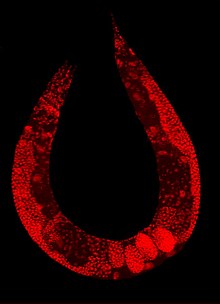Multicellular organisms
| Multicellular organism Temporal range: Mesoproterozoic–present |
|
|---|---|
 |
|
| In this image, a wild-type Caenorhabditis elegans is stained to highlight the nuclei of its cells. | |
| Scientific classification |
Multicellular organisms are organisms that consist of more than one cell, in contrast to unicellular organisms.
All species of animals, land plants and most fungi are multicellular, as are many algae, whereas a few organisms are partially uni- and partially multicellular, like slime molds and social amoebae such as the genus Dictyostelium.
Multicellular organisms arise in various different ways, for example by cell division or by aggregation of many single cells.Colonial organisms are the result of many identical individuals joining together to form a colony. However, it can often be hard to separate colonial protists from true multicellular organisms, because the two concepts are not distinct; colonial protists have been dubbed "pluricellular" rather than "multicellular".
Multicellularity has evolved independently at least 46 times, including in some prokaryotes, like cyanobacteria, myxobacteria, actinomycetes, Magnetoglobus multicellularis or Methanosarcina. However, complex multicellular organisms evolved only in six eukaryotic groups: animals, fungi, brown algae, red algae, green algae, and land plants. It evolved repeatedly for Chloroplastida (green algae and land plants), once or twice for animals, once for brown algae, three times in the fungi (chytrids, ascomycetes and basidiomycetes) and perhaps several times for slime molds and red algae. The first evidence of multicellularity is from cyanobacteria-like organisms that lived 3–3.5 billion years ago. To reproduce, true multicellular organisms must solve the problem of regenerating a whole organism from germ cells (i.e. sperm and egg cells), an issue that is studied in evolutionary developmental biology. Animals have evolved a considerable diversity of cell types in a multicellular body (100–150 different cell types), compared with 10–20 in plants and fungi.
...
Wikipedia
